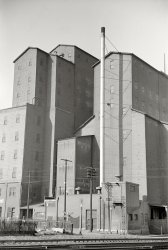
MAY CONTAIN NUTS

Search Shorpy
SHORPY ART

Framed or unframed, desk size to sofa size, printed by us in Arizona and Alabama since 2007. Explore now.
Join and Share
Ad-Free Shorpy
Shorpy is funded by you. Patreon contributors get an ad-free experience.
Learn more.

Recent comments
- What a headache!
- Baldwin 62303
- Baldwin VO-1000
- Cold
- No expense spared
- Tough Guys
- Lost in Toyland
- And without gloves
- If I were a blindfolded time traveler
- Smoke Consumer Also Cooks
- Oh that stove!
- Possibly still there?
- What?!?
- $100 Reward
- Freeze Frame
- Texas Flyer wanted
- Just a Year Too Soon
- WWII -- Replacing men with women at the railroad crossing.
- Yes, Icing
- You kids drive me nuts!
- NOT An Easy Job
- I wonder
- Just add window boxes
- Icing Platform?
- Indiana Harbor Belt abides
- Freezing haze
- Corrections (for those who care)
- C&NW at Nelson
- Fallen Flags
- A dangerous job made worse
Member Photos
The Shorpy
Print Emporium
Print Emporium
Search Shorpy
Search results -- 30 results per page
- The Reading Tree: 1939
- ... North Carolina." Photograph by Dorothea Lange for the Farm Security Administration. View full size.
Chair Haven't seen a chair ... Posted by Dave - 09/05/2012 - 4:10pm -
![The Reading Tree: 1939 July 1939. "Negro tenant farmer reading paper on a hot Saturday afternoon. Note vegetable garden across footpath. Chatham County, North Carolina." Photograph by Dorothea Lange for the Farm Security Administration. View full size.
ChairHaven't seen a chair like that in years. You used to see them at nearly every house out in the country. They were fairly easy to knock together from scrap wood.
[It's called an Adirondack chair. - Dave]
(The Gallery, Agriculture, Dorothea Lange, Rural America)](https://www.shorpy.com/files/images/8b34162u_1.thumbnail.jpg)
- Everywhere a Sign: 1939
- ... 35mm nitrate negative by Marion Post Wolcott for the Farm Security Administration.
Ducktown Today I've been through Ducktown a ... Posted by Dave - 09/11/2011 - 10:34am -
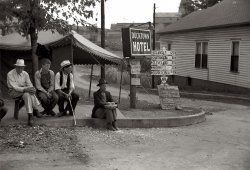
- My Little Piggy: 1941
- ... learn how to feed his pig properly." Photo by Russell Lee, Farm Security Administration. View full size.
Our Gang comedy in the making ... Posted by Dave - 10/18/2018 - 11:53am -
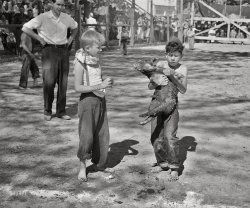
- Small Oil: 1939
- ... Oklahoma." Medium format negative by Russell Lee for the Farm Security Administration. View full size.
OSHA Quick, how many safety ... Posted by Dave - 06/02/2018 - 12:17pm -
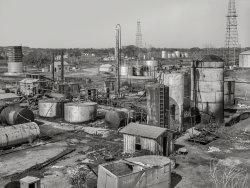
- Good for Life: 1942
- July 1942. "Nyssa, Oregon. Farm Security Administration mobile camp. Soda pop is delivered at the camp for ... Posted by Dave - 03/23/2016 - 1:21pm -
![Good for Life: 1942 July 1942. "Nyssa, Oregon. Farm Security Administration mobile camp. Soda pop is delivered at the camp for Japanese-Americans." Medium format nitrate negative by Russell Lee for the Office of War Information. View full size.
Summer jobMy summer job for four years in high school and college was working in the local Coca-Cola bottling plant, loading and unloading trucks like this one. There were no high-loaders or lifts, it was all done manually. To load a row of cases in the top rows, you had to climb up the side of the truck and push with your foot, since the row was too heavy to push by hand (at least for me). To unload empty cases, you could usually push the row by hand, but you still had to climb the side of the truck to grab them, depending on the height of the truck and how tall you were. Then, after unloading, all the empty cases had to be sorted by hand: all the Coke bottles in separate cases, all the Pepsi bottles in others, etc. Sometimes you'd find "strange" things in a returned empty bottle, e.g., a dead mouse or a cigar. One of the job's benefits was free Coke, all you wanted, and you soon learned that not all Coke tasted the same. The best was "post mix", the syrup used in fountains, where the syrup and carbonated water were mixed on the spot. Next best was "pre mix", where the syrup and water were pre-mixed in large metal cans, for businesses, county fairs, etc. The last was regular bottled Coke. This of course was in the days when Coke contained cane sugar, not high-fructose corn sugar. I thought I had the best summer job in town.
My First Impression"How come you're not in the service, mister?"
[Answered here. -tterrace]
Glass bottles = best tasteThe oldsters among us will know that those old time glass bottles, despite their inconvenience, gave one the best burst of flavor one could receive from a bottle of soda without the metallic tones of aluminum or the chemical betrayal of plastic. I fondly recall that at large summertime picnics usually put on by community groups, religious and ethnic clubs when I was a child, we always looked forward to the individual glass bottles of frigidly cold, fruity, delightful flavors and colors seen in those huge galvanized tubs containing vast amounts of crushed ice and nestled within that ice, like jewels, were tantalizing glass bottles of vivid lime green, bright orange, red cherry, purple grape, root beer and other tempting choices to enjoy with one's hot dog or burger. Since my siblings and I were always expected to share a single quart bottle when we were at home, at these special affairs we would each get our very own and would often drink ourselves silly. There really is something sensory and unique about a crystal clear, frigid, refreshing flavor from a glass bottled beverage on an oppressively hot, sweaty summer afternoon. Just another memory from the "long-ago" that will never come again.
Soda pop is deliveredThen empties are picked up and loaded.
Before there was a dosage recommendationIn later years, Dr Pepper eliminated the 'period', and the tag line became 10 - 2 - 4.
Those were the optimal times for the beverage.
(The Gallery, Cars, Trucks, Buses, Relocation Camps, Russell Lee)](https://www.shorpy.com/files/images/SHORPY-8c32512a.thumbnail.jpg)
- Comparing Cobs: 1939
- ... Iowa." Medium format negative by Arthur Rothstein for the Farm Security Administration. View full size.
"There are thousands and ... Posted by Dave - 09/08/2020 - 3:55pm -
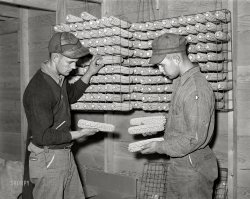
- Payne Service: 1939
- ... Medium format negative by Marion Post Wolcott for the Farm Security Administration. View full size.
Oh what I would give to ... Posted by Dave - 08/03/2019 - 1:43pm -
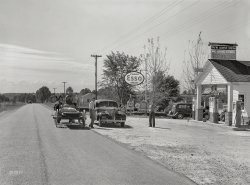
- Home Alone: 1937
- ... Divide County, North Dakota." Photo by Russell Lee for the Farm Security Administration. View full size.
TILT All together now: ... Posted by Dave - 03/02/2018 - 12:30pm -
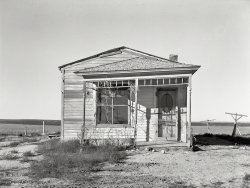
- Brakeman in Black: 1939
- ... Pacific Challenger ." Photo by Dorothea Lange for the Farm Security Administration. View full size.
40.709083N, 116.117243W -- ... Posted by Dave - 04/25/2018 - 1:02am -
![Brakeman in Black: 1939 June 1939. Carlin, Nevada. "Brakeman on the Union Pacific Challenger." Photo by Dorothea Lange for the Farm Security Administration. View full size.
40.709083N, 116.117243W -- looking SWIn 1939 Dor0thea Lange apparently, like Arthur Rothstein, drove across Nevada along the Lincoln Highway (now Interstate 80) taking pictures. In the town of Carlin, where B Street crosses the railroad tracks going south to West Main Street seems like it might have been the location where this particular image was photographed -- her camera pointed roughly southwest. A second train track now runs alongside. I wonder if the base of the tall old signal tower is the white electrical box there now.
Does he have all his fingers?A brakeman's job was historically very dangerous with numerous reports of brakemen falling from trains, or being run over or crushed by rolling stock. As rail transport technology has improved, a brakeman's duties have been reduced and altered to match the updated technology, and the brakeman's job has become much safer than it was in the early days of railroading. Individually operated car brakes were replaced by remotely-operated air brakes, eliminating the need for the brakeman to walk atop a moving train to set the brakes. Link and pin couplings were replaced with automatic couplings,and hand signals are now supplemented by two-way radio communication.
BrakemanMy uncle, who was a conductor on freight trains, said there were many accidents with the loss of limb as well as life. He would relate that in the station house you could see limbs laid against the wall when the injured were brought in. As a conductor, he would walk the roofs of the cars in all kinds of weather conditions and set the brakes on the cars individually as well as the brakeman. He was employed by the Pennsylvania RR for 49 years and had the run from Pittsburgh to Oil City, PA.
Western PacificCamera is looking SW, but the curve is the one at 40.71047N 116.107W, on the Western Pacific. In June 1939 train 88 was due out of Carlin at 1143 PST. The sign down there likely says West Carlin One Mile.
Passenger Train ConductorPart of a passenger train conductor's job was to be a brakeman. That job included "lining a route" for the train he was assigned to.
The conductor in the picture is part of the train crew assigned to the "Challenger", a named train on the Union Pacific Railroad.
A brakeman on a freight train would not be wearing a uniform like the one in the picture.
[Their caps say BRAKEMAN. - Dave]
(The Gallery, Dorothea Lange, Railroads)](https://www.shorpy.com/files/images/SHORPY-8b33534a.thumbnail.jpg)
- Granville County: 1939
- ... Medium-format nitrate negative by Dorothea Lange for the Farm Security Administration.
Oh! What a sweet looking child.
Granville ... Posted by Dave - 07/24/2012 - 7:05pm -
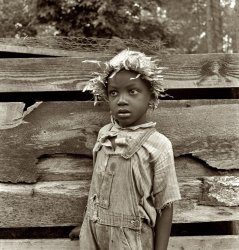
- Medicine Show: 1935
- ... full size. 35mm nitrate negative by Ben Shahn for the Farm Security Administration.
Or Minstrel Show? Medicine Shows were in the ... Posted by Dave - 09/09/2011 - 11:06am -
![Medicine Show: 1935 October 1935. Medicine show at Huntingdon, Tennessee. View full size. 35mm nitrate negative by Ben Shahn for the Farm Security Administration.
Or Minstrel Show?Medicine Shows were in the 1800s, mostly, and sold medicine--snake oil--and tended to use Indians. This appears to be a minstrel show instead?
[The caption cards for this and a similar photo both say medicine show. - Dave]
Medicine ShowThis is more likely to be a medicine show. A minstrel show performer would be much more elaborately costumed, and would probably (though not always) be a white performer in blackface.
Medicine shows often featured music and comedy playlets, almost always including a black stock character, and black musicians, all costumed much more rustically (as here). Indians were most often employed to lend credibility to the medicine's origins in the "natural healing arts of the Red Man".
Medicine ShowI've since had the pleasure of viewing other pictures from this set. This is definitely a "blackface" player in a medicine show. I have good reason to believe that this is Tommy Scott from Doc Chambers' Medicine Show. Scott played guitar, sang, performed in blackface, and did a ventriloquism act (note the ventriloquist dummy in front).
(The Gallery, Ben Shahn, Kids, Small Towns, Sports)](https://www.shorpy.com/files/images/8a16826u.thumbnail.jpg)
- Baby on Board: 1939
- ... October 1939. Baby from Mississippi in truck at the Farm Security Administration camp at Merrill, Oregon. View full size. Photograph ... Posted by Dave - 09/07/2011 - 9:54pm -
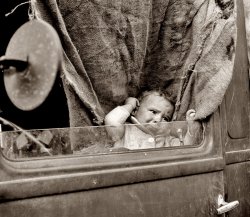
- Davenport: 1940
- ... size. 35mm nitrate negative by Arthur Rothstein for the Farm Security Administration.
Davenport Bridge It seems that this is the 2nd ... Posted by Dave - 12/20/2007 - 11:39am -
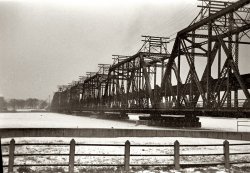
- Mormon Fridge: 1940
- ... produces the cooling effect." Photo by Russell Lee for the Farm Security Administration. View full size.
Wrapped and Unwrapped ... Posted by Dave - 07/17/2018 - 9:03pm -
![Mormon Fridge: 1940 April 1940. " 'Mormon refrigerator' used by caretaker at Tonto National Monument, Gila County, Arizona. Water placed in tin container on top drips over the burlap and rapid evaporation in the atmosphere produces the cooling effect." Photo by Russell Lee for the Farm Security Administration. View full size.
Wrapped and UnwrappedNearby child produces "the cooling effect" in a different way.
Ames Harris Neville desert water bagAs mentioned: "Saturate Before Using."
How appropriate!
Also known asThe Coolgardie Safe.
Works on the same principle as the desert water bag, another simple and effective invention employing evaporative cooling. Desert water bags, of course, being made by such companies as Ames Harris Neville, and probably dime a dozen in desert climes during the '40s.
[Also the same principle as the "swamp cooler." - Dave]
In Greenhouses TooI see this principle used in large scale in industrial greenhouses here in Florida - they'll make one wall out of absorbent material and put drip sprinklers all along the top. Fans and vents keep the cool air moving through the greenhouse. It's fascinating to see.
Grandma knewIn the summer months, she would hang burlap over the curtain rods and place a pan of water on the window sill with the bottom of the burlap curtain in the water with the window open. A poor man's air-conditioner.
(The Gallery, Kids, Kitchens etc., Russell Lee)](https://www.shorpy.com/files/images/SHORPY-8b24561a.thumbnail.jpg)
- Near Ophir: 1940
- ... Ophir, Colorado." Acetate negative by Russell Lee for the Farm Security Administration. View full size.
Barrels I see small ... Posted by Dave - 10/01/2018 - 10:52am -
![Near Ophir: 1940 September 1940. "Trestle of narrow gauge railroad near Ophir, Colorado." Acetate negative by Russell Lee for the Farm Security Administration. View full size.
BarrelsI see small platforms with steel barrels, placed at intervals along the far side. What purpose do the barrels serve?
[Fire extinguishers. - Dave]
It's a long way downHow 'bout that for a clever title for my comment?
Dual purposeIs that standard gauge also on the trestle?
**********
Thanks to both Steamcrane and Wormy for the guard rail information. I knew of standard gauge guard rails, but not the narrow gauge type.
As always, Shorpy is informative as well as artistic and entertaining.
Outside guard railsThe smaller section rails outside the running rails are intended to keep derailed cars from going completely off the trestle deck. Additionally, there are guard timbers at the ends of the ties as a last resort.
On a standard gauge railroad, the guard rails would be between the running rails, with the guard rails brought together at a point at the end. Not so good with tippy narrow gauge cars.
With modern welded rails, and very few bolted joints, the chance of a spontaneous derailment is greatly reduced, and the guard rails are now frequently omitted, especially if passenger trains do not use the line.
Also note the extended timbers on the near side, presumably to allow laying down planks to make maintenance work easier.
Safety RailsThe outer rails are there to keep the trucks traveling relatively straight over a trestle, viaduct, or bridge during a derailment. A rough ride but better than the alternative.
AcrophobiaI seem to have Ophir of heights.
(The Gallery, Railroads, Russell Lee)](https://www.shorpy.com/files/images/SHORPY-8b26089a1.thumbnail.jpg)
- Coop de Ville: 1939
- ... Heights, last seen here . Photo by Russell Lee for the Farm Security Administration. View full size.
Yuck! The open window of ... Posted by Dave - 06/04/2018 - 11:22am -
![Coop de Ville: 1939 November 1939. "Old mansion in Comanche, Texas." Our second look at the pigeon roost otherwise known as Oakland Heights, last seen here. Photo by Russell Lee for the Farm Security Administration. View full size.
Yuck!The open window of that turret room probably has resulted in a massive pigeon-dropping mess.
Bird houseHas anyone cracked that house is for the birds?
But seriously, it's a fascinating house and I would like to know more about it -- when was it built and where can it be found on Google Maps? Comanche is a very small town but I can't find it.
[Possibly because it no longer exists. - Dave]
You can't get there from hereYou can't find this house because it was torn down in the 1950s. Oakland Heights stood on the western half of the block bounded by North Austin Street, West Neely Avenue, North Houston Street, and West Walcott Avenue. The modern-day address would be 107 West Walcott.
It was built shortly after 1887 by Dexter Walcott, for whom the street was named. Unfortunately, he didn't get to enjoy it much; he died suddenly and his widow had to superintend completion.
Much of the foundation is still there. If you look at the street view on Googlemaps, you can make out what I believe to be the right side foundation still there including the stairway going up on the side of the gazebo looking porch. Fascinating.
(Thank you Marchbanks for the address info).
Its replacementIs somewhat impressive in its own right. I looked on Google Maps and found the lot as described by Marchbanks. The sign out front says it's 105 West Walcott, and it's a shingle-sided, split level ranch, T-shaped in plan view. On the east side of the lot is what appears to be stonework from Oakland Heights' original foundation walls, backfilled with dirt and covered with grass, creating a terraced yard. Yeah, I'd live there.
Has a Mr. Hitchcock lived nearby?I can see where some ideas came from.
(The Gallery, Russell Lee)](https://www.shorpy.com/files/images/SHORPY-8b23404a1.thumbnail.jpg)
- Late for the Sky: 1941
- ... format acetate negative by Marion Post Wolcott for the Farm Security Administration. View full size.
Miles and Miles of nothing ... Posted by Dave - 09/14/2019 - 6:37pm -
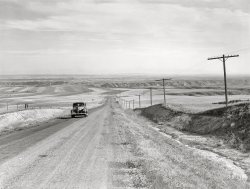
- Merry-Go-Round: 1938
- ... full size. 35mm nitrate negative by Ben Shahn for the Farm Security Administration.
Polkadot dress Sure reminds me of Ma Kettle
... Posted by Dave - 09/09/2011 - 12:31pm -
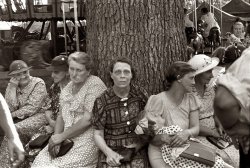
- The Pearly Gates: 1941
- ... Medium format acetate negative by John Vachon for the Farm Security Administration. View full size.
Dante More like the Gates ... Posted by Dave - 06/08/2020 - 10:46am -
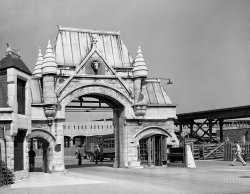
- City Terminal: 1941
- ... terminal." Medium format negative by John Vachon for the Farm Security Administration. View full size.
Gulf Tower So prominent then at 44 ... Posted by Dave - 01/31/2020 - 9:25pm -
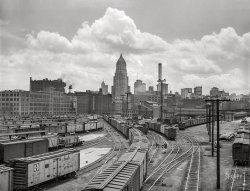
- G Is for Grundy: 1940
- ... Medium format acetate negative by Arthur Rothstein for the Farm Security Administration. View full size.
Much is still the same ... Posted by Dave - 02/20/2020 - 1:36pm -
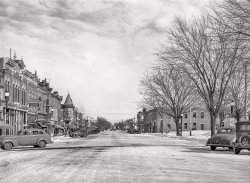
- Starter House: 1939
- ... Seen earlier here . Photo by Dorothea Lange for the Farm Security Administration. View full size.
Needs of babies With the ... Posted by Dave - 10/25/2013 - 5:30pm -
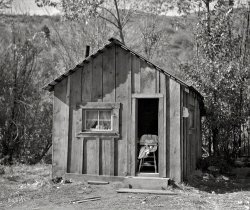
- Gridlock: 1941
- ... Georgia." A show of hands. Photo by Jack Delano for the Farm Security Administration. View full size.
Almost defies caption I ... Posted by Dave - 08/27/2013 - 12:36pm -
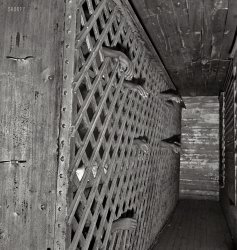
- The Good Earth: 1937
- ... size. 4x5 nitrate negative by Arthur Rothstein for the Farm Security Administration.
Belle Glade The dark, black soil is called ... Posted by Dave - 09/05/2012 - 4:12pm -
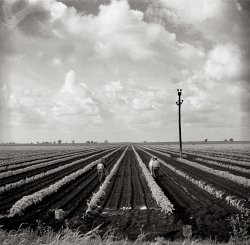
- Hyattsville: 1940
- ... Maryland." Acetate negative by Jack Delano for the Farm Security Administration. View full size.
Old stomping grounds I ... Posted by Dave - 03/26/2019 - 7:34pm -
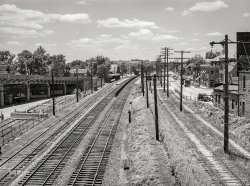
- Lesser Newark: 1939
- ... Medium format negative by Arthur Rothstein for the Farm Security Administration. View full size.
Cutting-edge business ... Posted by Dave - 11/30/2017 - 4:00pm -
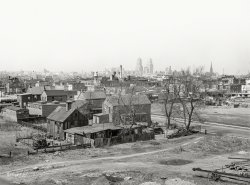
- Froid Depot: 1941
- ... format acetate negative by Marion Post Wolcott for the Farm Security Administration. View full size.
En hiver, c'est vrai, sans ... Posted by Dave - 09/08/2019 - 12:12pm -
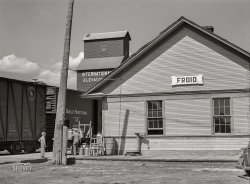
- Dr. Springs: 1939
- ... Medium format acetate negative by Arthur Rothstein for the Farm Security Administration. View full size.
First name Leaf The good ... Posted by Dave - 07/14/2020 - 11:31am -
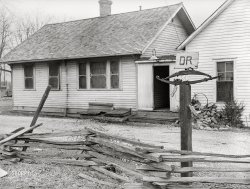
- The 8 Ball: 1940
- ... across the Sacramento River. Photo by Russell Lee for the Farm Security Administration. View full size.
Sawdust Memories To me the ... Posted by Dave - 12/10/2018 - 10:57am -
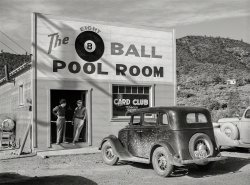
- The Bun Also Rises: 1939
- ... on riverfront." 35mm negative by Arthur Rothstein for the Farm Security Administration. View full size.
Elevated prose Alternate title: ... Posted by Dave - 02/09/2012 - 3:35am -
